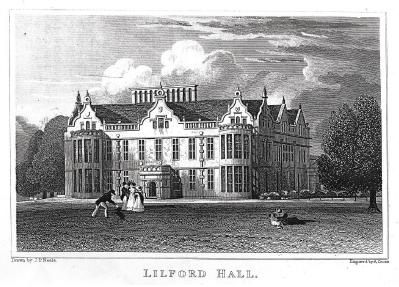History of Lilford Hall
Lilford Hall is a Grade I listed stately 100 room home with a 55,000 sq ft floor area, located in the eastern part of the County of Northamptonshire in the United Kingdom. A Grade I listed building is considered by the UK Government as of outstanding architectual and historic interest. Lilford Hall and the associated parkland of 350 acres is located north-west of the village of Lilford, part of the parish of Lilford-cum-Wigsthorpe and Thorpe Achurch.
 Lilford Hall was first built as a Tudor mansion in 1495, and later was greatly extended as a Jacobean-style gentry house of the 1630s, related closely with Thorpe masons through its parallels with other neighbouring houses such as Kirby Hall and Apethorpe Hall. Its plan is traditional and arranged around a 'U-shaped' court with the hall entered by a screens passage, the Great Chamber placed over the hall, leading to the principal apartment that terminated with the Great Bed-chamber.
Lilford Hall was first built as a Tudor mansion in 1495, and later was greatly extended as a Jacobean-style gentry house of the 1630s, related closely with Thorpe masons through its parallels with other neighbouring houses such as Kirby Hall and Apethorpe Hall. Its plan is traditional and arranged around a 'U-shaped' court with the hall entered by a screens passage, the Great Chamber placed over the hall, leading to the principal apartment that terminated with the Great Bed-chamber.
Its development by successive generations respected the old house, but each stage has a clarity that is clearly legible and contributes to the whole. Apart from the construction of the pair of balancing stable wings by Henry Flitcroft and the successive addition of small scale extensions in the form of additional storeys to the east end of the two wings, works were confined to alterations within the house and remodelling.
The Jacobean house is considered as of considerable significance, and Henry Flitcroft's alterations in the 1740s are of a similar status. The outstanding contribution of Henry Flitcroft was with his insertion of a comprehensive set of 18C Georgian interiors that not only transformed the principal rooms into a sequence of Palladian spaces, but brought light into the heart of the building. The play of the sequence of 18C Georgian rooms within the structure of the Jacobean house is one of the most notable features of the house.
(1).jpg)
For further information on various aspects of the history of Lilford Hall, please Click here for a brief architectural history of Lilford Hall, Click here for a full architectural history of Lilford Hall, Click here for a history of the Park at Lilford, Click here for a history of Parish and Manor of Lilford, and Click here for a history of The Walled Garden.
Click here for more historical photographs of Lilford Hall.

Lilford Hall and its Estate are best known for being the family home of Robert Browne (1550-1633), who is considered as 'The Father of the Pilgrims' and 'The Grandfather of the Nation' (USA). Robert Browne is important in American history (for further information Click here) since he acted on the idea of separation of Church from State, and was the person who effected the first step in American democracy.
In particular, he was a prominent Elizabethan Separatist and the founder of the Brownists, a common designation for early Separatists from the Church of England before 1620. He was the first seceder from the Church of England, and the first to found a Church of his own in 1581 on Congregational principles (namely the Church goers themselves electing their preacher). A number of his followers were hanged for distributing his books on religious reform, which led to his followers (including the Mayflower passengers) becoming the first wave of people in 1620 escaping from religious persecution to America. These followers of Robert Browne were originally known as the "Brownist Emmigration", but 200 years later they became commonly known as the Pilgrims. Robert Browne lived at Lilford Hall many different times during his whole life, ending up in mid age returning to the Church of England to permanently live on the Lilford Estate. For further information on Robert Browne, please Click here.
